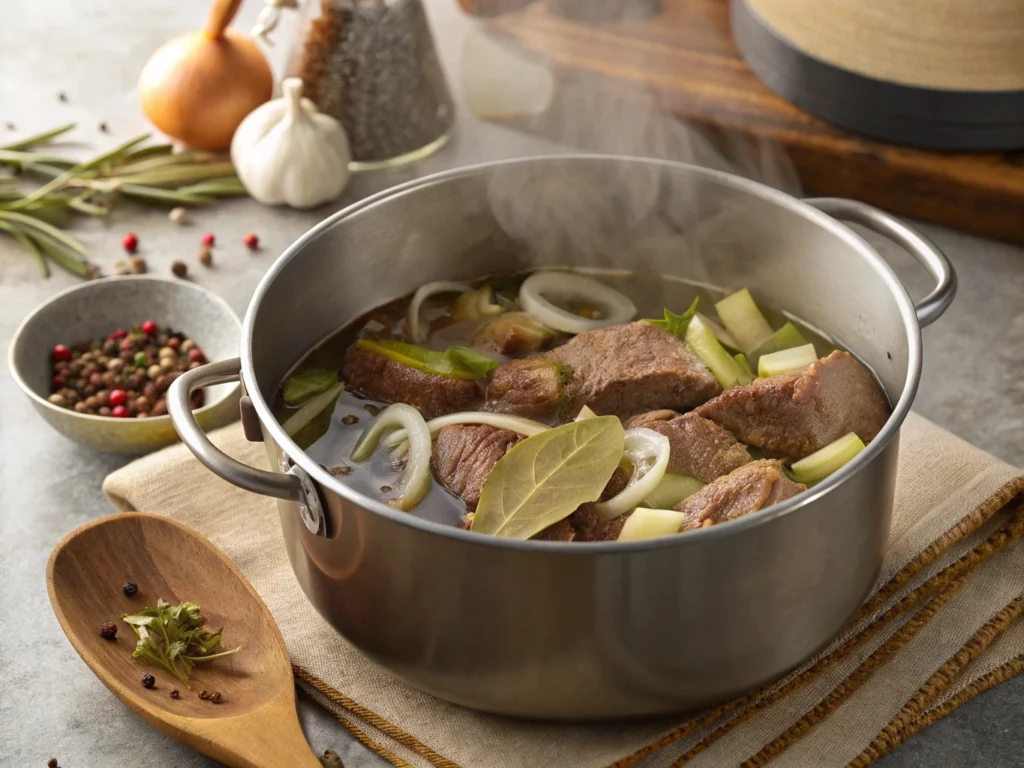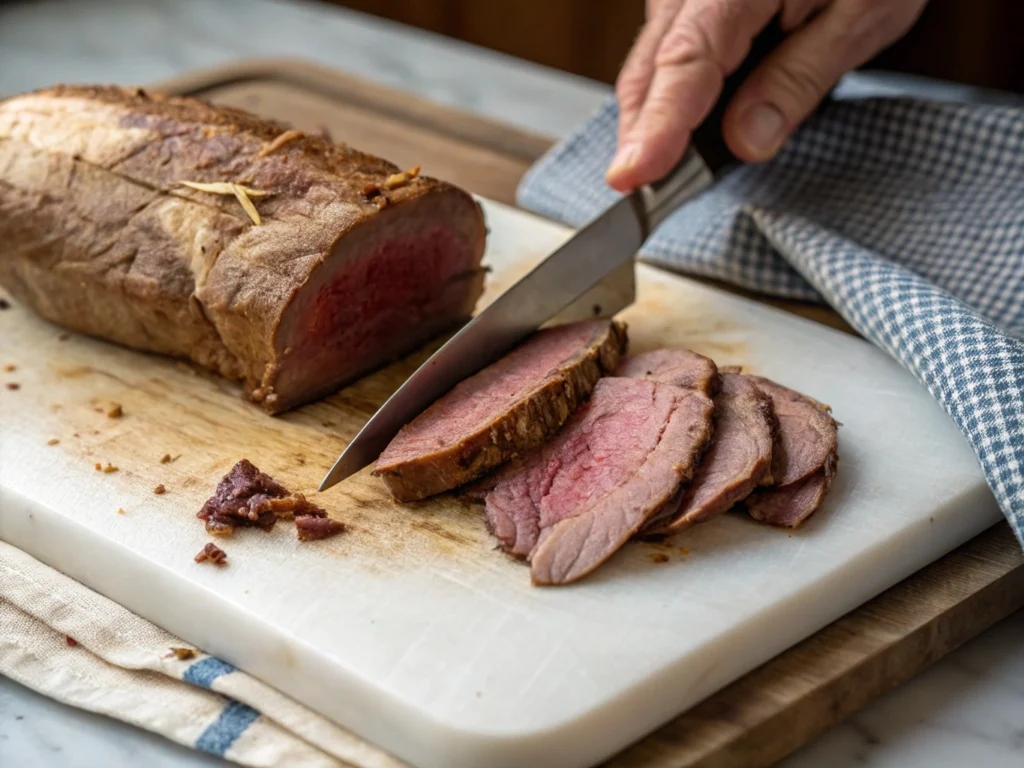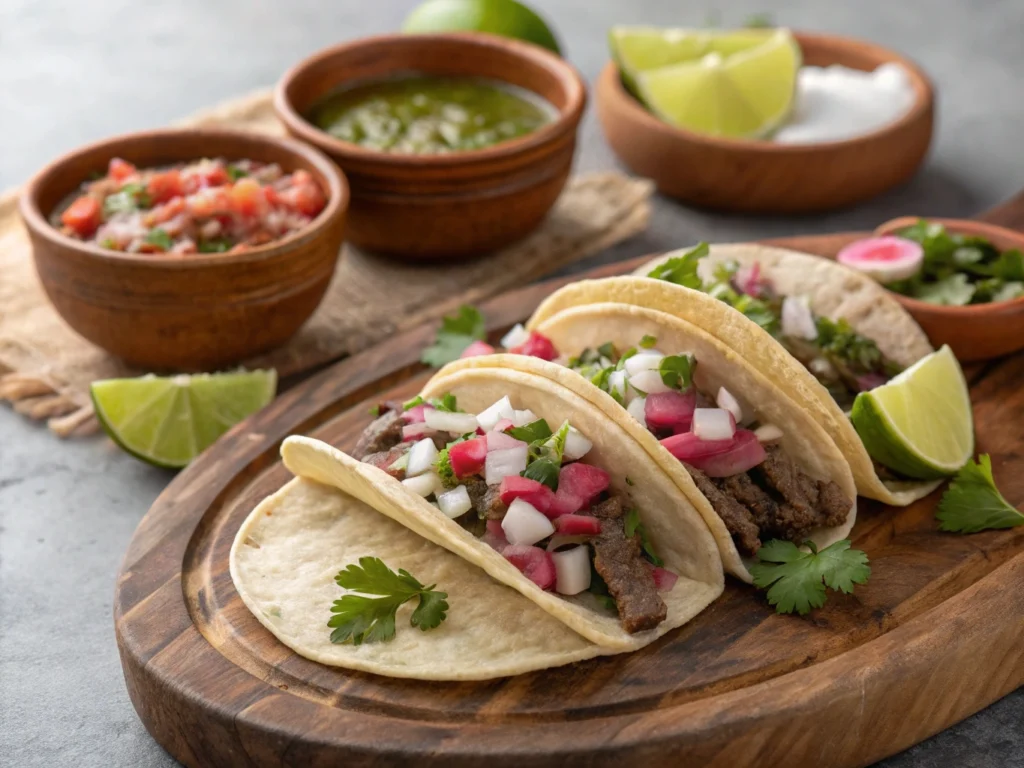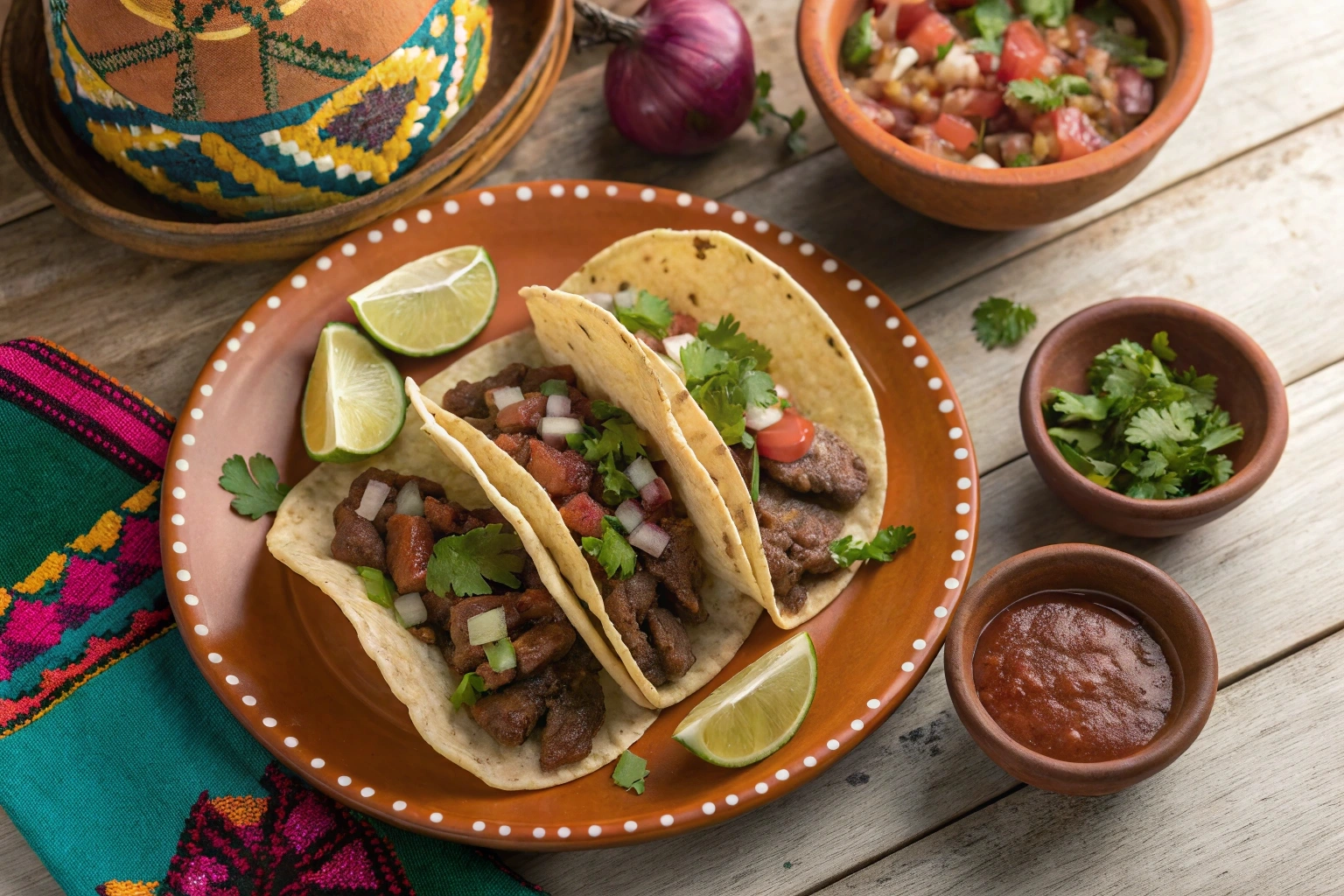When it comes to authentic Mexican cuisine, nothing beats the bold flavors and rich history of tacos de lengua. This isn’t just a taco; it’s a culinary tradition passed down through generations. Slow-cooked beef tongue, infused with fragrant spices, is the star here delicately tender and full of savory goodness.
The beauty of tacos de lengua lies in their simplicity. It’s not about flashy ingredients; it’s about letting the natural flavors shine. Serve them with warm tortillas, fresh lime, and your favorite toppings, and you’ve got a meal that feels both humble and indulgent. Whether you’re hosting a fiesta or craving something unique for dinner, these tacos are sure to wow your taste buds. Let’s get cooking you’re going to love this!
Secret 1: Choosing the Best Beef Tongue
Selecting the right beef tongue is the foundation of crafting unforgettable tacos de lengua. The quality of the meat directly impacts its flavor, tenderness, and overall success in your recipe. Let’s break it down step by step.
What to Look for When Buying Beef Tongue
When shopping for beef tongue, look for one that’s fresh and firm, with no discoloration or unpleasant odors. A good beef tongue should have a smooth surface, a consistent pinkish-brown color, and feel slightly moist to the touch. If possible, source your tongue from a butcher or a market specializing in fresh meat, as they often carry higher-quality cuts.
While packaged beef tongue is convenient, fresh options from trusted sources tend to yield better results. For those new to cooking beef tongue, don’t hesitate to ask your butcher for tips on preparation. This ensures you’re starting with the best possible base for your tacos de lengua.
Why Quality Matters
High-quality beef tongue isn’t just about taste it’s also about texture. A fresh, well-chosen tongue will cook evenly, resulting in a tender, melt-in-your-mouth experience. On the other hand, a subpar cut may have tough sections or an off-putting flavor, which could ruin your tacos.
Moreover, premium-quality meat absorbs seasonings better, giving your tacos de lengua a rich depth of flavor. Choosing wisely at this stage ensures the rest of your cooking process is smooth and stress-free.
Storage Tips
If you’re not cooking the tongue immediately, proper storage is key to maintaining its quality. Keep it in the coldest part of your refrigerator, ideally in a sealed container or vacuum-sealed bag. Beef tongue can stay fresh for up to three days in the fridge.
For longer storage, freezing is a great option. Wrap the tongue tightly in plastic wrap and then place it in a freezer-safe bag. Be sure to label it with the date, as frozen beef tongue is best used within three months. Thaw it slowly in the refrigerator when you’re ready to cook.
Trusted Sources for Beef Tongue
For the freshest beef tongue, consider shopping at local Mexican markets or specialty butcher shops. Some online retailers, such as Heritage Foods, also offer high-quality beef tongue that can be delivered straight to your door. These sources often prioritize sustainable practices and provide detailed information about their products, ensuring you know exactly what you’re getting.
When sourcing your ingredients, remember that the extra effort to find a premium cut will elevate your tacos de lengua from good to unforgettable.
Secret 2: Preparing the Beef Tongue

To make truly exceptional tacos de lengua, preparation is key. From cleaning to brining, the way you handle the tongue sets the stage for a flavorful and tender dish. Let’s walk through the essential steps.
Cleaning the Beef Tongue Properly
Before cooking, the beef tongue needs to be thoroughly cleaned. Rinse it under cold water, scrubbing away any surface debris. Pay close attention to the nooks and crannies, as this ensures your tacos de lengua have a clean, fresh taste. If your tongue has been frozen, let it thaw completely in the refrigerator before cleaning.
For an extra step, soak the tongue in cold water with a splash of vinegar for 30 minutes to remove any lingering odors. This quick trick can make a big difference in the final flavor!
Optional Pre-Brining
Brining the tongue is a fantastic way to infuse flavor and ensure tenderness. Combine water, salt, garlic, bay leaves, and a handful of peppercorns in a large container to create a simple brine. Submerge the tongue in the mixture and refrigerate it for 4–12 hours.
Although this step isn’t essential, it enhances the meat’s ability to absorb seasonings during cooking, resulting in unforgettable tacos de lengua.
Tools You’ll Need
A few basic tools make preparing beef tongue much easier. Here’s what you’ll need:
- Stockpot: Large enough to accommodate the tongue and aromatics.
- Sharp Knife: Crucial for peeling and slicing the cooked tongue.
- Cutting Board: A sturdy surface for preparation.
- Tongs: To handle the tongue while it’s hot.
Having these tools on hand simplifies the preparation process and ensures that your cooking experience is hassle-free.
Ready for the Next Step
Now that your beef tongue is cleaned and prepped, you’re ready to move on to cooking it to tender perfection. In the next section, we’ll explore how to achieve that ideal texture and flavor through slow cooking and pressure cooking techniques. Stay tuned for more!
Secret 3: Cooking the Beef Tongue to Perfection
Cooking beef tongue may seem intimidating, but with the right techniques, you can achieve tender, flavorful results perfect for tacos de lengua. Here’s how to do it step by step.
The Slow Cooking Method
Slow cooking is one of the best ways to make beef tongue tender and packed with flavor. Start by placing the cleaned tongue in a large stockpot. Add aromatics like garlic cloves, onion, bay leaves, and peppercorns. Cover it with water, bring it to a boil, and then reduce to a simmer.
Let the tongue cook gently for about 3–4 hours, or until a knife easily pierces the thickest part. The slow cooking process allows the collagen in the tongue to break down, resulting in the melt-in-your-mouth texture that makes tacos de lengua so delicious.
Pressure Cooking for Quick Results
If you’re short on time, a pressure cooker is your best friend. It delivers tender beef tongue in a fraction of the time. Place the tongue and aromatics in the pressure cooker, add enough water to cover, and cook at high pressure for 60–75 minutes.
Once the cooking is complete, allow the pressure to release naturally before opening the lid. The result is just as flavorful as slow cooking but much faster—perfect for busy weeknights when you’re craving authentic tacos de lengua.
Aromatics and Seasonings
The beauty of beef tongue lies in how well it absorbs flavors. To enhance your tacos de lengua, include aromatic ingredients like garlic, onion, and fresh herbs during cooking. For extra depth, consider adding a teaspoon of cumin or a dried chili for subtle heat.
These seasonings infuse the meat with rich, complex flavors, ensuring every bite of your tacos is bursting with authenticity. Keep the seasonings simple to let the natural flavor of the tongue shine.
For additional inspiration, explore our guide to seasoning essentials for meats. It’s packed with tips for taking your dishes to the next level.
Secret 4: Peeling and Slicing the Beef Tongue

Once your beef tongue is perfectly cooked, the next step is preparing it for your tacos de lengua. Peeling and slicing may sound tricky, but with these tips, it’s straightforward and stress-free.
How to Peel the Beef Tongue Easily
Peeling the beef tongue is much easier while it’s still warm. After removing it from the pot or pressure cooker, let it cool slightly—just enough so you can handle it without burning your hands.
Using a sharp knife, make a small slit in the thick outer skin. From there, the skin should peel away easily, much like removing a jacket. Be sure to discard all the tough, leathery outer layer to reveal the tender meat underneath. This step is crucial to ensure your tacos de lengua have the perfect texture.
Slicing for Tacos
Once peeled, it’s time to slice the tongue. For traditional tacos de lengua, thin slices are ideal. Aim for slices about ¼ inch thick, as these are easy to layer into tortillas and hold toppings well.
If you prefer diced meat, you can cut the slices into small cubes after slicing. This option works especially well if you want your tacos to have a more uniform texture with each bite.
Pro Tips for Dicing
For those who enjoy tacos with a chunkier filling, dicing the tongue is an excellent choice. Once you’ve sliced the tongue into manageable pieces, dice it into small, bite-sized cubes. A sharp knife will help you achieve clean, even cuts.
Lightly sautéing the diced tongue in a hot skillet with a splash of oil can add a touch of crispness and amplify the flavors. This step is optional but highly recommended if you want to take your tacos de lengua to the next level.
To elevate your taco night further, try pairing your tacos de lengua with a fresh homemade salsa.
Secret 5: Perfecting the Toppings and Tortillas
To truly elevate your tacos de lengua, the toppings and tortillas must be just as delicious as the meat itself. These finishing touches bring everything together and add layers of flavor and texture.
Essential Toppings for Authentic Tacos
The beauty of tacos de lengua lies in their simplicity. The traditional toppings—fresh cilantro, diced onion, and a squeeze of lime enhance the flavor of the tender beef tongue without overpowering it.
For an extra burst of flavor, try adding salsa verde or a smoky chipotle sauce. Both options pair beautifully with the savory meat. If you like a bit of crunch, thinly sliced radishes make an excellent addition.
Homemade vs. Store-Bought Tortillas
While store-bought tortillas are convenient, homemade corn tortillas make a world of difference in flavor and texture. They’re softer, fresher, and have a subtle sweetness that perfectly complements the rich beef tongue.
If you’re using store-bought tortillas, warm them up on a hot skillet or over an open flame to bring out their natural flavors.
How to Warm Your Tortillas
Warming your tortillas is a crucial step that’s often overlooked. A warm tortilla is pliable, enhances the toppings, and prevents tearing.
- Stove-Top Method: Heat a skillet over medium-high heat and toast each tortilla for about 30 seconds on each side until warm and slightly charred.
- Microwave Method: Wrap tortillas in a damp paper towel and microwave for 20–30 seconds.
- Oven Method: Stack tortillas, wrap them in foil, and warm them in a 350°F oven for 10 minutes.
These methods ensure your tacos de lengua have the perfect base to hold all those delicious toppings.
Pairing Toppings for Maximum Flavor
To add variety, consider mixing traditional and modern toppings. For instance, pair the classic cilantro and onions with creamy guacamole or crumbled queso fresco. If you love spicy food, pickled jalapeños or a drizzle of hot sauce can take your tacos to the next level.
Experimenting with combinations allows you to create your own signature version of tacos de lengua. Don’t be afraid to get creative you might just discover your new favorite taco topping!
Bringing It All Together

With tender beef tongue, freshly prepared tortillas, and a medley of toppings, your tacos de lengua are ready to shine. Assemble your tacos with care, layering each component thoughtfully, and enjoy every bite of this authentic Mexican classic.
FAQs
What kind of meat is lengua?
Lengua is the Spanish word for beef tongue, a flavorful and tender cut of meat. It’s highly prized in many cuisines, especially in Mexican cooking, for its rich texture and ability to absorb seasonings. When cooked correctly, beef tongue becomes incredibly tender and is perfect for making tacos de lengua, where the meat is sliced or diced and served in tortillas with traditional toppings like cilantro, onion, and lime.
What is the meaning of tacos de lengua?
Tacos de lengua translates to “tongue tacos” in English. These tacos feature beef tongue as the main ingredient, prepared by slow-cooking or pressure-cooking the tongue until it’s tender and flavorful. The meat is then peeled, sliced, and served in corn tortillas with classic toppings. This dish is a staple in Mexican cuisine and is beloved for its melt-in-your-mouth texture and savory taste.
How do you make a taco tongue?
To make beef tongue for tacos de lengua, start by cleaning the tongue thoroughly. Then, cook it either by simmering it in a pot with water, garlic, onion, bay leaves, and peppercorns for 3–4 hours or by using a pressure cooker for faster results. Once cooked, peel off the tough outer skin, slice or dice the meat, and season it to your liking. Serve the tongue in warm tortillas, topped with cilantro, onion, lime, and salsa for an authentic and delicious taco experience.
Are lengua tacos good for you?
Yes, lengua tacos can be a nutritious option when enjoyed as part of a balanced diet. Beef tongue is rich in protein, B vitamins, and minerals like zinc and iron, which are essential for energy and immune function. However, it’s also higher in fat, so portion control is important if you’re watching your calorie intake. When paired with fresh toppings like cilantro and onions and served in moderate portions, tacos de lengua can be both satisfying and nourishing.
Conclusion
Tacos de lengua aren’t just a meal they’re a journey into the heart of authentic Mexican cuisine. From selecting the freshest beef tongue to preparing it with care and serving it in warm tortillas with flavorful toppings, every step is an opportunity to create something truly special.
So, roll up your sleeves and dive into making your own tacos de lengua. With this guide, you’ll be able to create a dish that’s not only rich in flavor but also steeped in tradition. Share your culinary adventure with friends and family, and don’t forget to enjoy every bite of this classic taco masterpiece!

